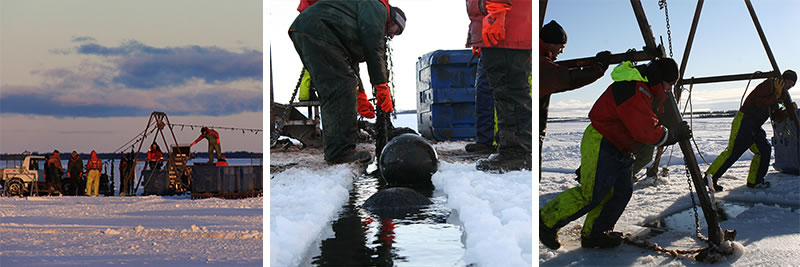On The Farm
The spring and summer of the following year, the farmer will continue to add flotation to the long lines as the PEI Mussels continue to grow. Unlike some shellfish, there is no one season in which mussels are harvested. They remain flavourful and available year round. The size of the meat will vary depending on the time of year.
PEI Mussels are a naturally occurring shellfish in the waters where we farm. Everything that a mussel requires to survive and grow is supplied by the nutrients in the water column. However, to ensure access to ample quantities of food and to protect the mussels from predators, mussel farmers must continually care for their crop. As the crop grows and the mussel socks gain weight the mussel farmer is busy adding floatation to the long lines.
The most important factor to successful mussel farming is clean, clear waters. To ensure that this happens, farmers place their ropes in areas where the waters are pristine, which our Prince Edward Island waters are known for. The Canadian Shellfish Sanitation Program also oversees regular testing of coastal waters to ensure that the waters are clean, and the mussels are free from toxins.
PEI mussels are harvested to order and shipped fresh to you all year round.

Mussel Harvesting
After 18 to 24 months, PEI Mussels reach a marketable size of 55-60 mm. At this point harvest-ready long lines can contain upwards of 2 tonnes of mussels each.
In winter, bays and estuaries are covered in ice (upwards of 125 cm or 4 ft). As a result, mussel long lines are sunk approximately 2-3 ft below the surface. Lines destined for harvest over the winter are marked with ice-poles or GPS markers. Specialized techniques are used to harvest PEI Mussels through the ice. Growers use chain saws and special blades to cut through the ice. The line is hauled up through the ice by a portable winch. Mussels are cut by hand from the long line and stored in insulated plastic boxes that protect the product from wind-chill.
During the rest of the year, PEI Mussels are harvested in open water by boats equipped with a boom and a hydraulic winch. The backline is partially lifted out of the water, and the socks are cut from the backline and hauled into the boat. To minimize losses, the boat may be equipped with an aluminum chute to guide the long line and socks onboard.
Mussel Processing
Once harvested, PEI Mussels are transported to nearby federally inspected and registered processing plants, where they are stripped from the sock, de-clumped, washed, graded and have their beards (byssal threads used) removed.
The PEI Mussels are inspected, and any broken or substandard shells are removed prior to being packed for shipping to markets all over North America.